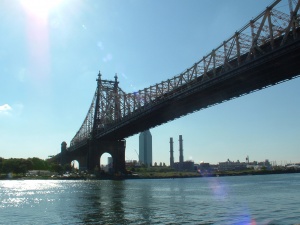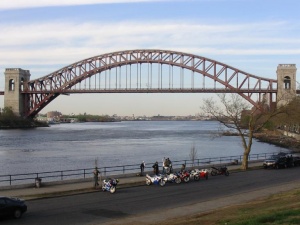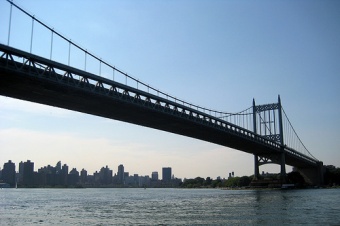Views
Historic Overview
Contents |
Origins
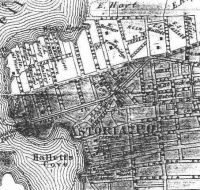
Originally known as Hallet's Cove, Astoria was founded by William Hallett, Sr. in the 1650s. Hallet bought the land, which was home to German immigrants, from the governor Peter Stuyvesant.[2] Hallet's Cove remained a small neighborhood, with less than twenty houses, for two centuries. In 1835, Stephen Halsey, a fur merchant, moved to Hallet's Cove, and obtained a village charter in 1839. He named the village Astoria after John Jacob Astor (a friend and fellow fur merchant). Halsey had hoped that this would encourage Astor to donate money to the village, but Astor refused and never entered the town named for him.[3] Halsey's projects included laying out streets and avenues and constructing buildings, many of which still stand today. He created a ferry station at 92nd street in Manhattan, bought farms, and donated property to be used for schools and churches (such as the Presbyterian Church and the Astoria Catholic Church). He served as one of the Trustees and the President of the Board for the welfare of the village. Halsey became known as the "Father of Astoria" for his dedication and efforts to the village of Astoria.[4]
Moving into the 19th Century
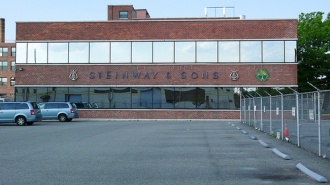
At the beginning of the 19th century, wealthy New Yorkers settled between 12th Street and 14th Street, in an area called Astoria Village (now called Old Astoria). However, life in New York City became more commercialized and industrialized in the later part of the century, increasing levels of European immigration and demands for real estate in Astoria. Astoria became the destination for German immigrants, specifically cabinet-makers.[6] One notable German immigrant, Henry Steinway, was instrumental in the transformation of Astoria from a village to a community. He opened Steinway Piano Factory in 1853, and proceeded to pave streets, open a streetcar line, a church, and a school (that taught German as a second language and offered the first free kindergartens in the United States). This became the region in Astoria known as Steinway Village, which was created for workers at the Steinway Piano Factory. (For more information on German and other immigrants, see Immigrants in Astoria.)
Becoming Part of New York City
Astoria, Steinway Village, and surrounding villages were incorporated into Long Island City in 1870, and Long Island City was incorporated into New York City in 1898. However, the greatest change to Astoria was facilitated by the construction of the Queensborough Bridge in 1909. It was the first in a series of new modes of transportation that made Astoria more accessible from Manhattan.[7] The Hell Gate Bridge (originally known as the East River Arch Bridge) was completed in 1916 and connected Astoria to Randall and Ward's Islands.[8] The Second Avenue Train, opened in 1917, connected Long Island City to Manhattan. The Triborough Bridge, completed in 1936, connected Manhattan, Bronx, and Queens. (It was recently renamed the RFK Bridge after Robert F. Kennedy.) A total of six tunnels and five bridges link Long Island City to New York City.[9]
...................Queensborough Bridge[10]...................................................Hell Gate Bridge[11]........................................................Triborough Bridge[12]..............................
Return to Astoria or visit Astoria's Borders | Immigrants in Astoria | Housing in Astoria | Contemporary Profile | Interesting Facts | Explore Astoria | Testimonials of Residents | Conclusions
Citations
- ↑ http://images.google.com/imgres?imgurl=http://www.forgotten-ny.com/streetnecrology/astorianecro/halletts.jpg&imgrefurl=http://www.forgotten-ny.com/streetnecrology/astorianecro/astoria.html&usg=__N2aZl8TI-bGAEXoPtWCFP6CRrYI=&h=430&w=453&sz=43&hl=en&start=1&sig2=tplsmUOhf0GwTUzMUss66g&um=1&tbnid=ol9hPfFCXA1vLM:&tbnh=121&tbnw=127&prev=/images%3Fq%3Dhallett%2527s%2Bcove%26hl%3Den%26client%3Dfirefox-a%26rls%3Dorg.mozilla:en-US:official%26sa%3DN%26um%3D1&ei=wUbKSYyGN6CwmQeB_LH0Ag
- ↑ "Astoria." Answers.com. 2009. 26 Apr 2009 <http://www.answers.com/topic/astoria-new-york>.
- ↑ “The History of Astoria and Long Island City.” 2004. MyAstoria.com. 13 Apr 2009 <http://www.myastoria.com/history/>.
- ↑ "Stephen Halsey." Greater Astoria Historical Society. 26 Apr 2009 <http://www.astorialic.org/topics/people/halsey_p.php>.
- ↑ http://farm4.static.flickr.com/3150/2544832345_5a1ea70362.jpg?v=0
- ↑ "About Astoria Queens, NY." AstoriaQueens.com. 26 Apr 2009 <http://astoriaqueens.com/>.
- ↑ “The History of Astoria and Long Island City.” 2004. MyAstoria.com. 13 Apr 2009 <http://www.myastoria.com/history/>.
- ↑ "Hell Gate Bridge: Historic Overview." The Crossings of Metro New York. 26 Apr 2009 <http://www.nycroads.com/crossings/hell-gate/>.
- ↑ “The History of Astoria and Long Island City.” 2004. MyAstoria.com. 13 Apr 2009 <http://www.myastoria.com/history/>.
- ↑ http://wpcontent.answers.com/wikipedia/commons/thumb/8/80/Queensboro_Bridge.jpg/250px-Queensboro_Bridge.jpg
- ↑ http://www.bridgeandtunnelclub.com/bigmap/queens/astoria/astoriapark/xhellgate.jpg
- ↑ http://farm2.static.flickr.com/1102/1032654193_e0e7451167.jpg
